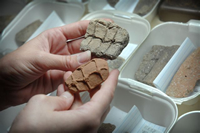Archaeologists Explore Salt’s Well Preserved Impact on Earlier Societies
By Chris Bryant
If you were living 1,000 years ago, among your primary concerns would have been obtaining salt. Yep, sodium chloride… good ol’ table salt.
Oh, sure, we take it for granted today. But, spend a few minutes with Dr. Ian Brown, and you may never again feel the same after picking up a shaker of the stuff.
“Wars have been fought about it,” Brown says of salt. “Wars have been won and lost as a result of it. Think of it as analogous to oil today. If we don’t have it, we have to get it from someone who does, if we want to satisfy that need.”
Brown, an archaeologist, gets how rarely we think about salt today, even though it’s still vital, of course, to our survival. He’s often met with blank stares and long pauses when he mentions its importance in history.
“Whenever I say I’m teaching a course on ‘salt and civilization’ people say, ‘ok? …’ It’s only when you start looking at the history of it do you realize how critical it is for people.”
Ashley Dumas has also seen the empty expressions and heard the awkward pauses. The UA doctoral student built her anthropological dissertation around salt seeps, and the tens of thousands of prehistoric pottery pieces she’s excavated from various sites.

One site, along the east bank of Alabama’s Tombigbee River in southern Clarke County, seems today to have only Dumas’ interest. That wasn’t always the case. Indians of the Mississippian culture, and others, flocked to the site to obtain the commodity and left behind, for Dumas to collect hundreds of years later, bits and pieces of the salt pans used in the production process. And while it’s the Mississippian-era people that Dumas is most interested in, tangible evidence shows another group, Confederate soldiers, were also desperately interested in the Clarke County sites.
“The salt springs that flow well today are the ones that were incased in pipes by the Confederate soldiers,” Dumas says. “They are actually still flowing out of the hollowed out cypress logs that the Confederates bored and sunk.”
A Salt-Less Army

Some of the blue and gray clad soldiers even blamed their ultimate defeat on the lack of white gold, as it’s been called. “A number of confederate generals said after the war that the reason they lost was that they didn’t have the salt to run an army,” says Brown, a professor of anthropology in UA’s College of Arts and Sciences. “An army runs on its belly. You’ve got to feed them to keep them happy.”
The Union’s naval blockade prevented England from replenishing the South with its increasingly dwindling, and much-needed, provisions, including salt, Brown points out. But, long before the days of Grant and Lee a different sort of historical transition brought salt to the forefront.
“It’s no coincidence that Indians began to make salt at about the same time they began to grow corn,” Dumas says. “You can look anywhere in the world, and anywhere you find a civilization that began to rely on agriculture for a major portion of their diet, they begin to seek sources of salt. Prior to this, people were hunting and gathering and may have been absorbing enough salt to maintain their health sort of incidentally, through eating fish and other animals.”
Importance to Indian Cultures

Dumas is primarily interested in the role salt played in three different Indian cultures, the Bottle Creek chiefdom, their near contemporaries the Moundvillians, and these two group’s predecessors, the Late Woodland Indians. You can tell how important salt was to these groups by the amount of time and effort they put into obtaining it, Dumas says.
During a period ranging from 1000 to 1400 AD, these peoples invested heavily in salt production. Dumas has the rubberized containers to p rove it. She’s excavated enough salt pan and pottery fragments from the sites to fill 35, five-gallon buckets and some 20 tubs, with each tub storing multiple gallon bags containing fragments.
The Mississippian people, Dumas says, dug shallow pits, some 20 inches in diameter and lined them with fabric. They then pressed clay into the fabric, forming the pans, and allowing them to air dry and harden. Later, clutching the fabric, they lifted the pans from pits, and peeled off the fabric before firing the pans. Natural brine flowing from the seeps was collected in the pans and allowed to evaporate in the sun, leaving behind the salt. “This process was different from how Late Woodland people were boiling it over an open flame.”
Unimportant at the time, but fascinating to the archaeologists that followed, was something else left behind – imprints the fabrics made onto the pans. The types of knots tied can be identified by the imprints along with clues to the types of materials used to line the pits.
Dumas says the process appears to have been a family affair. “They may have been doing it at a time of the year that their labor was not needed in the fields or in other activities – perhaps later summer or early fall, after the harvest but before the rains of late November.”
Some of the evidence, Dumas says, points toward the salt springs being the initial draw for the Mississippian settlements developing in southwest Alabama. “We know that somebody who was familiar with Moundville culture was in Clarke County at the salt springs because we find small amounts of Moundville style pottery at the salt springs, and we don’t find it anywhere else in southwest Alabama.”
Salt Pays for Eerie Canal

Dumas’ mentor, Brown, who has traveled as far England and China to study salt’s importance in history, concurs and points out it wasn’t only the Moundvillians who went to great lengths for salt.
“The old Indian paths, some of which later became roads; those original paths were the same ones Indians took to get to salt springs. You look at where the principal cities are – Nashville, Cincinnati, Syracuse – all these places were major cross roads with salt springs on them. Most people don’t realize it, but Syracuse was the Venice of America. It was a city built on canals. Salt was being taken in and out by barges.”
Not convinced of salt’s impact? That’s ok, Brown is just warming up.
“The Eerie Canal was built because of salt. Most people think of it as the link between the West and East for moving goods, but it was salt that paid for its production.” Even the word salary comes from the Latin root for salt, Brown points out, as the Roman soldiers were once paid in salt. The French revolution was triggered by a tax on salt.
It’s a safe bet that no salt-based revolutions are percolating today, but don’t mistakenly think it’s unimportant, Brown says. “If you went to New York City right now and said, ‘ok, you’ve got a week without salt,’ they’re going to die. You can’t go a long time without salt.”
Once people developed refrigeration techniques, the perceived importance of salt began waning. “The thing that killed salt, in terms of people realizing its importance, was when it was no longer needed for preservation,” Brown says. “We tend to think of it today as something that is bad for you, and it is, in excess, but everyone needs it.”
“It was Alabama’s first industry…salt making,” Dumas says. “There was plenty of small production going on for perhaps thousands of years prior, but as far as making a commodity for one’s self and for trade, I would argue salt as the first.”
“That’s why,” Brown chuckles, “I tell my students, ‘salt rules!’”
Further Reading